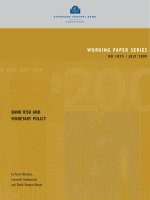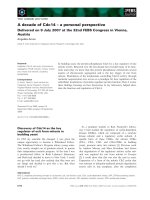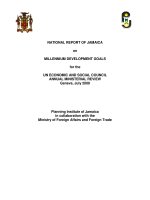- Trang chủ >>
- Đề thi >>
- Đề thi lớp 12
Solutions preparatory problems IChO 2015 july 20
Bạn đang xem bản rút gọn của tài liệu. Xem và tải ngay bản đầy đủ của tài liệu tại đây (1.49 MB, 62 trang )
IChO-2015
Solutions to Preparatory Problems
Worked solutions
to preparatory problems
47th International Chemistry Olympiad
(IChO-2015)
Moscow State University
Baku Branch
Azerbaijan
Please, send all the comments and questions to:
Vadim Eremin ()
Sasha Gladilin ()
Sent to head mentors
February 16, 2015
Released on the web-site
May 31, 2015
1
IChO-2015
Solutions to Preparatory Problems
Contents
Theoretical problems
Problem 1.
Problem 2.
Problem 3.
Problem 4.
Problem 5.
Problem 6.
Problem 7.
Problem 8.
Problem 9.
Problem 10.
Problem 11.
Problem 12.
Problem 13.
Problem 14.
Problem 15.
Problem 16.
Problem 17.
Problem 18.
Problem 19.
Problem 20.
Problem 21.
Problem 22.
Problem 23.
Problem 24.
Problem 25.
Problem 26.
Brayton cycle
Liquefied natural gas
Carnot cycle
Quasi-equilibrium model
The Second Law of thermodynamics applied to a chemical reaction
Catalytic transformation of a single molecule on a single nanoparticle
Esterification of a dicarboxylic acid
Three elements
Simple experiments with copper(II) chloride
An element typical for Azerbaijan mud volcanoes expelled water
The Prussian blue
Substitution in square planar complexes
Redox equilibria in aqueous solutions
Determination of acetylsalicylic acid purity
Chemical dosimeter
Determination of water in oil
Oxidation and inspiration
Essential ozone
Two in one
Antitussive “narcotine”
Pyrrolizidine alkaloids
Delightful odor of truffle
Synthesis of large rings. The magic or routine work?
What Time is it in Baku or Cheating the Death
Number One Enzyme
Holy War against Four Horsemen of the Apocalypse
3
5
6
7
9
11
12
14
15
16
17
18
19
20
21
23
26
28
32
33
35
37
38
41
45
47
Practical problems
Problem 27.
Problem 28.
Problem 29.
Problem 30.
Problem 31.
Problem 32.
Problem 33.
Problem 34.
Determination of nickel in nickel and copper-nickel alloys
by complexometric titration
Titrimetric determination of lead and silver in their mixture
Complexometric determination of iron, chromium, and zinc in an alloy
Synthesis of 3-(4-methylbenzoyl)propionic acid
Synthesis of 4-(4-methylphenyl)-4-hydroxybutanoic acid
Synthesis of diethyl ester of succinic acid
Kinetic studies of Norfloxacin oxidation with permanganate
in alkaline medium
Temperature dependence of the reaction rate of disproportionation
2
52
54
54
56
57
60
61
63
IChO-2015
Solutions to Preparatory Problems
Theoretical problems
Problem 1. Brayton cycle
1. As can be seen from the figure, there are many possible ways to go from point A (1 bar, 298 K)
to point B (8 bar, 298 K) using only adiabatic and isobaric segments. The work W is equal to the
area under the path. It is clear that W is minimal if we complete the process in two stages: isobaric
cooling and then adiabatic compression.
10
B
p/bar
8
6
4
2
A
0
0
10
V/l
20
30
We will derive a general formula to calculate the work of transformation from (p1, T1) to (p2, T2) in
two stages. If for the reversible adiabatic process pV
5/ 3
RT
p
p
5/ 3
const , then
T 5/3
const , or
p 2/3
p1
T
T
T
const
.
After
the
isobaric
stage,
the
pressure
is
still
p
and
the
temperature
is
1
2
p 2/5
p2
2/ 5
.
p 2/ 5
3
The work at the adiabatic stage is W2 U RT2 1 1 , and at the first stage
p2
2
3
IChO-2015
Solutions to Preparatory Problems
2/ 5
p1
W1 p1 V1 V R T1 T2 .
p2
2/ 5
In
total,
p
3
5
W W1 W2 RT1 RT2 RT2 1 .
2
2
p2
If
p 2 / 5
1 2/5
5
5
1
T1 T2 , then W RT2 1 . Thus, W 8.314 298 1 3500 J.
8
p2
2
2
In a reversible isothermal compression, W RT ln
p2
5150 J.
p1
2. The maximum work is done when the first stage is adiabatic and the second one is isobaric. We
can use the same formula for the reverse process and obtain the work with the opposite sign.
p 2/5
8 2/5
5
5
2
W RT2 1 8.314 298 1 8040 J.
1
p1
2
2
3. According to the first law of thermodynamics, Q W U W . The total work done on the gas
1 2/ 5
5
during three steps is: W 3 RT2 1 = 4500 J.
2
2
4. The maximum efficiency is achieved when the area of the cycle is the largest, i.e. when we
complete
the
cycle
in
four
steps:
cooling,
compression,
heating,
expansion.
Then
8040 3500
0.565 . All the efficiencies from 0 to 0.565 are possible, if we go in more steps.
8040
5. The work W done on gas during cooling and compression stages can be found from equation
8040 W
0.379 ; W = 4993 J.
8040
If the number of steps is n, then x 81/ n . Since the work at each step is the same, the total work is:
1 2/ 5n
5
W n RT2 1 . After some calculations with different integer n, we find that n = 13.
8
2
6.
8040 3500
0.393 .
8040 3500
4
IChO-2015
Solutions to Preparatory Problems
Problem 2. Liquefied natural gas
1.
T = 0.49 + 443 / (3.99 – log p) = 111.5 K
300
bar
pressure
at
298
K,
40000
m3
2.
Under
have
the
mass
m
pVM 300 105 40000 0.016
16800
7.75 106 kg, or 7750 tons. Thus, LNG has
2.17
RT
8.314 298
7750
times larger energy density.
3. The pressure inside the tank is the saturated vapor pressure of methane at the given temperature:
log p = 3.99 – 443 / (273.15–159–0.49) = 0.0924, p = 1.24 bar. Using the diagram, one can
calculate the distance between two black points at log p =0.1 to be about U 7.2 kJ mol 1 . Thus,
H U RT 8.1 kJ mol 1 .
4. Total heat obtained by methane is Q 50000 3600 24 15 6.48 1010 J. It will lead to
evaporation of
Q
M 1.28 105 kg, or 128 tons, or 0.76 % of methane.
H
5. Total heat obtained by methane is Q 50000 3600 24 9 30.5 1.19 1012 J. It will lead to an
Q
1.19 1012
0.016 3.39
increase of the internal energy per mole of methane by U M
m
16800000 / 3
kJ·mol–1. From the diagram, the initial internal energy at –159 °C is 0.1 kJ·mol–1. The abscise of the
point corresponding to the final state on the diagram will thus be approximately 0.1 + 3.4 = 3.5
kJ·mol–1. The ordinate is log p = 1.2. The ratio of the lengths of the line segments from this point to
the borders of the phase coexistence curve (blue and red line segments in the figure below) is equal
to the ratio of the number of moles of methane in vapor and liquid phases. One can find that about
6/51 = 12% of methane is in the gas phase.
6. The maximum possible temperature is the critical temperature of methane, corresponding to the
maximum of log p vs U curve. From the diagram we find log pc = 1.65, then pc= 44.7 bar and Tc =
0.49 + 443 / (3.99 – log p) = 190 K.
5
IChO-2015
Solutions to Preparatory Problems
2
lg(p/bar)
1.5
liquid
1
0.5
gas+liquid
0
-0.5
gas
-1
-2
-1
0
1
2
3
4
5
6
7
8
U/(kJ·mol-1)
Figure. Graphical answer to question 5
Problem 3. Carnot cycle
1. This is impossible because we do not know the number of moles of a gas.
2.
T2 T1 390 298
0.24 .
T2
390
3. Since pV
1 R /CV
RT
p
p
1 R /CV
1 R /CV
T
T
const , then
const , or R / CV R const . Thus, we
R /CV
p
p
can find CV from the initial and final temperatures and pressures of the adiabate:
ln
T2
T1
ln
p2
R / CV R
p1
p
CV R ln 2
p1
ln
T2
1 3 R.
T1
4. It can be any number from 3 and above (the molecule should be non-linear).
6
IChO-2015
Solutions to Preparatory Problems
Problem 4. Quasi-equilibrium model
1. In this case, the quasi-equilibrium step precedes the rate-limiting one,
r1 r–1,
k1[A][B] k1[AB]
and
[AB]
k1
[A][B] .
k 1
Using the stationary state condition
d [AB* ]
0 one gets
dt
r keff [A][B] k3[AB* ] k2 [AB]
k1k2
[A][B]
k1
keff
k1k2
200 M 1 s 1
k1
2.1. Maximum partial pressure of F2 will be attained if the equilibrium is reached in the reaction
F2
2F
K p 1.7 103 bar 1
(2a).
pF2
p
2
F
; pF 10 5 bar
pF2 1.7 107 bar
Partial pressure of molecular fluorine near the surface is negligible.
2.2. It is safe to assume that quasi-equilibrium is achieved in the reaction
Pt(s) + PtF4(g) = 2PtF2(g)
The measured ratio
2
pPtF
2
pPtF4
(2b)
is equal to the equilibrium constant of this reaction.
2.3. One may assume that quasi-equilibrium is also achieved in the reaction
Pt(s) +2F(g) = PtF2(g)
within the desorbed flow. Then
7
(2c)
IChO-2015
Solutions to Preparatory Problems
1/2
pFDes
pPtF2
K (eq. 2c)
p
1/2
2 106
8
5 10
4 1015
1/2
6.3 108 bar
2.4. For the gasification of platinum, the following mechanism could be proposed:
PtF2 , PtF4
F(Inс)
F(Des) Pt (s)
Here the rate-limiting step is “equilibration” of atomic fluorine on the surface. It precedes the quasiequilibrium steps. “Equilibrated” fluorine takes part in the quasi-equilibrium gasification of Pt.
Interaction products do not accumulate on Pt surface. Hence
FInс FDes 2 PtF2 4 PtF4 ,
or
pFInс
1/2
(mF )
pFDes
1/2
(mF )
2
pPtF2
1/2
(mPtF2 )
4
pPtF4
(mPtF4 )1/2
.
Under the experimental conditions (see the Table and question 2.2)
pFInс
2
1/2
(mF )
pPtF2
(mPtF2 )1/2
The rate of gasification is
rPt
dnPt
PtF2 PtF4 PtF2 FInс
dt
2
2.5. As it was shown in 2.4,
pFInс
2
(mF )1/2
pPtF2
(mPtF2 )1/2
pFInс 105 bar, pPtF2 2 106 bar,
2
2.6.
rPt
pPtF2 (mF )1/2
1/2
pFInс (mPtF2 )
0.4
4.35
0.1
15.26
dnPt
PtF2 PtF4 PtF2 FInс
dt
2
rPt PtF2
pFIn
0.1
0.1
0.1
F,In
NA
2 1018 1017 atoms/cm2 /s
1/2
2
2 (2mF RT )
2
8
IChO-2015
Solutions to Preparatory Problems
In 15 minutes,
15 60 1017 9 1019 atoms/cm 2 1.5 10 4 mol /cm 2 = 0.029 g/cm2
will be gasified.
Problem 5. The Second Law of thermodynamics applied to a chemical reaction
1.1.
nH 2O nCO2 6nC6 H12O6 nO2
1.2. If spontaneous chemical reaction is the only process in the reactor, ΔGsystem < 0.
The value of for spontaneous reaction is positive, Δni are positive for the products and are
negative for the reactants (minus sign makes them positive!). Thus,
GReaction
GSystem
0.
2. Since both forward and reversed reactions are elementary ones, the following equality may be
written at equilibrium:
r1 k1[A]eq [B]eq r1 k 1[C]eq
and
[C]eq
k1
K
k1 [A]eq [B]eq
[C]eq, [B]eq, [A]eq are concentrations at equilibrium, K is the equilibrium constant of the reaction.
Making use of the well-known formula
G 0 RT ln K
from equation (2) one gets
[C]
[A][B]
k
[C]
RT ln 1 RT ln
k1
[A][B]
G RT ln K RT ln
k
[C]
r1
RT ln 1
RT ln
r1
k1 [A][B]
9
(3)
IChO-2015
3.1.
Solutions to Preparatory Problems
(a ') GReaction G
0
Reaction
[HBr]2
RT ln
[H 2 ][Br2 ]
0
(a '') GReaction GReaction
RT ln
[HBr][Br]
[H][Br2 ]
0
( a ''') GReaction GReaction
RT ln[СO2 ]
3.2.
Equation (3) may be used only in case (a''). Other two reactions are not elementary ones.
4.
robs r1 r1
r
r
1 1 0.5; 1 0.5
r1
r1
r1
r1
r1 k 1 [C]
k
2
k
1
0.5; 1 0.125 M
r1
k1 [A][B] k1 0.5 1
k1
k1
K 8 M 1
k 1
5.
robs
robs
ΔG=const
r-1=const
(b)
(a)
r1= r -1
r1
r1
robs
r1=const
(c)
ΔG
10
IChO-2015
6.
Solutions to Preparatory Problems
Table.
r
r1
r1/r–1
GReaction
r/r1
+
+
–
–
–
Problem 6. Catalytic transformation of a single molecule on a single
nanoparticle
1. a) VAu nano = 4/3πR3 = 1.1310–19 cm3, mAu nano =1.1310–19 cm3 19.32 g/cm3 = 2.1810–18 g,
NAu atoms = 2.1810–18 g / 196.97 6.021023 = 6675 atoms.
b) f = Vsurface / VAu nano = (VAu nano – Vcore) / VAu nano = 1 – (r3(core)/r3(Au nano)) = 1 – (3–0.7)3/33 =
0.55.
2. Suppose you detect a signal from a particular 1μm2 area. The probability to have one particle
within this area is 0.035. For two particles such probability is (0.035)2 and for three it is equal to
(0.035)3 etc.
The probability that the detected signal originates from a single Au nanoparticle is:
p
0.035
0.035 0.0352 0.0353 ......
0.035
1 0.035 0.965 96.5%
1
1
1 0.035
3. В is the only fluorescent molecule in the system. The fluorescence of B in the solution could not
be detected under the experimental conditions. Thus the signal is detectable as long as B is seating
on the Au nanoparticle. The consistent height of the peaks (Fig.2) indicates that each peak comes
from a single molecule – were it from many molecules, the peaks would have variable heights
depending on the number of molecules.
4. [τ2] is an average time necessary to desorb a single molecule B from a single catalytic site on Au
nanoparticle. The rate of desorption of B molecules from a single catalytic site of Au nanoparticle is
rdes [ 2 ]1 kdes {molecules of B desorbed / time}
where kdes is the rate constant for one catalytic site.
11
IChO-2015
Solutions to Preparatory Problems
[τ1] is the average time necessary to form a single molecule B on a single Au nanoparticle.
The number of catalytic sites occupied by substrate A is
A m
K ads [A]
m
1 K ads [A]
All these sites equally participate in catalytic formation of a single B on a single Au nanoparticle,
rcat
kcat m Kads [A]
[1 ]1 {molecules of B formed / time}
1 Kads [A]
where kcat is the rate constant for one catalytic site.
5.
11 , 2 1
2 1
( 11 ) 10
[A]
Fig. 3. [ 2 ]1 , [ 1 ]1 vs [A]
[τ2]–1 is independent of [A], [τ1]–1 increases with the increase of [A] and approaches constant value
when Kad[A] >> 1 (see Answer 4)
6. [τ2]–1 does not vary. [τ1]–1 is proportional to the number of catalytic cites, m, which is in turn
proportional to the area of the surface of Au nanoparticle. [τ1]–1 varies as the square of diameter i.e.
in our case increases by a factor of 4. (See Answer 4).
Problem 7. Esterification of a dicarboxylic acid
Denote A = acid, E = ethanol, M = monoester, D = diester. Consider two equilibria:
M + H2 O
A+E
K1 =
[M][H 2O]
= 20
[A][E]
D + H2 O
M+E
K2 =
[D][H 2O]
= 20
[M][E]
12
IChO-2015
Solutions to Preparatory Problems
(here water is not a solvent but a product, therefore, it enters the expressions for equilibrium
constants).
The equilibrium yield of monoester is:
[A][E]
[M]
[M]
1
[H 2O]
=
=
=
=
2
[H 2O]
[E]
[A][E]
[A][E]
[A]0
[A] [M] [D]
1 K2
[A] K1
K1K 2
2
K1[E]
[H 2O]
[H 2O]
[H 2O]
K1
Denote [H2O] / [E] = x, then ( x ) =
1
x
K
1 2
K1
x
this function has maximum value at x =
. By differentiating with respect to x, we find that
K1K2 : max =
1
K
1 2 2
K1
. At K1 = K2 = 20, the maximum
yield of monoester is: max = 1/3.
Substituting the optimal ratio [H2O] / [E] into the equilibrium constants, we find the relations:
[M] = [A]
K1
,
K2
[D] = [A].
From the material balance with respect to water we get:
[H2O] = [M] + 2[D] = [A] 2
[E] =
K1
,
K2
2
[H 2O]
1
= [A]
KK
K 2
K1K 2
1 2
The initial concentrations of ethanol and acid are:
2
1
K
[E]0 = [E] + [M] + 2[D] = [A]
[A] 1 2[A] ,
KK
K 2
K2
1 2
[A]0 = [A] + [M] + [D] = [A] [A]
K1
[A] .
K2
And the optimal ratio is:
X =
[E]0
=
[A]0
2
1
K1
2
K2
K1K 2 K 2
2
K1
K2
= 1
13
1
.
K1K 2
IChO-2015
Solutions to Preparatory Problems
At K1 = K2 = 20, the optimal ratio is X = 1.05.
Answers.
1.
X = 1.05.
2.
max = 1/3.
3.
X = 1
1
, max =
K1K2
1
K
1 2 2
K1
.
Problem 8. Three elements
Let the valences of elements A, B, and C be a, b, c, respectively. (Do not confuse valences and
oxidation numbers!) The formulas of three compounds are: AbBa, BcCb, AcCa. From the mass
fractions we can determine the ratios of atomic masses to valences:
(A in AbBa) =
bM (A)
= 0.75
bM (A) aM (B)
M (A)
M (B)
=3
a
b
(B in BcCb) =
cM (B)
= 0.078
cM (B) bM (C)
M (C)
M (B)
= 11.8
c
b
We see that the ratio M(B) / b is the smallest one. Considering several elements with small ratios of
atomic mass to valence, we easily find, that B is carbon: M = 12, b = 4, then A is aluminium: M =
27, a = 3, and C is chlorine: M = 35.5, c = 1. The compounds are: Al4C3, CCl4, and AlCl3.
The mass fraction of chlorine in aluminum chloride is:
(Cl in AlCl3) =
3 35.5
= 0.798 = 79.8%.
3 35.5 27
This result can be obtained without determining the exact formula of AcCa. Indeed, from the above
relations, we find that
M (C)
M (A)
= 3.93
. Therefore,
c
a
M (C)
aM (C)
3.93
c
(C in AcCa) =
=
=
= 0.798 .
M (A) M (C) 1 3.93
cM (A) aM (C)
a
c
14
IChO-2015
Solutions to Preparatory Problems
Problem 9. Simple experiments with copper(II) chloride
1. A diluted solution of copper chloride is blue due to [Cu(H2O)6]2+ ions. Upon the concentration of
the solution its color changes to green, as the substitution of coordinated water molecules by
chloride-ions occurs:
[CuCl4]2– + 6H2O.
[Cu(H2O)6]2+ +4Cl–
2.
2+
+
OH 2
H2O
OH 2
OH 2
Cu
H2O
H2O
Cl
Cu
OH 2
H2O
OH 2
OH 2
OH 2
OH 2
OH 2
H2O
Cl
H2O
Cl
Cl
Cu
Cu
OH 2
Cl
Cl
OH 2
OH 2
See: Bernd M. Rode and Saiful M. Islam. Structure of aqueous copper chloride solutions: results
from Monte Carlo simulations at various concentrations // J. Chem. Soc. Faraday Trans., 1992,
88(3), 417-422.
3.
(a) CuCl2 + Zn = Cu + ZnCl2 (red precipitate – copper),
(b) 2CuCl2 + 4NaI = 2CuI + I2 + 4NaCl (grey precipitate – mixture of copper iodide and
iodine),
(c) no noticeable changes,
(d) CuCl2 + Na2S = CuS + 2NaCl (black precipitate).
Copper is completely reduced in (a), and partly reduced in (b) and (d). Surprisingly, copper sulfide
CuS is a mixed sulfide-disulfide of copper (+1) and copper(+2).
4. A possible synthetic route is the reduction of copper by zinc followed by chlorination.
CuSO4 + Zn = ZnSO4 + Cu
Cu + Cl2 = CuCl2.
15
IChO-2015
Solutions to Preparatory Problems
Another way is metathesis reaction with barium chloride with crystallization of hydrated copper
chloride. The dehydration can be achieved by heating with thionyl chloride:
CuSO4 + BaCl2 = BaSO4 + CuCl2
(from solution CuCl22H2O forms).
CuCl22H2O + 2SOCl2 = CuCl2 + 2SO2 + 4HCl
Problem 10. An element typical for Azerbaijan mud volcanoes expelled water
1. The general formula of an oxide is XOn. The molar ratio of X to O is:
31.0 69.0
:
= 1: n
M (X) 16
n = 0.5; 1; 1.5; 2 etc.
n = 0.5 gives M(X) = 3.6 no element.
n = 1 gives M(X) = 7.2 Li, but it doesn’t exist in +2 oxidation state.
n = 1.5 gives M(X) = 10.8 B. It’s true as boron generally exists in +3 oxidation state. X is B.
In water solution boron forms anionic oxo-species, the counter ion could be sodium as one of
dominant ions in expelled water. The common boron mineral that contains sodium is borax
Na2B4O710H2O, it contains 11.3 wt.% of boron.
X – B, Y – Na2B4O710H2O.
2. The density of the diluted solution is 1 kg/L, then 1 ppm is 1 mg/L, 250 ppm is 250 mg of boron.
The mass of borax is: m(Na2B4O710H2O) = 250 / 0.113 = 2212 mg = 2.2 g.
3. The mass loss under gentle heating of borax is 37.8% that corresponds to the loss of 8 water
molecules.
The anion (H4B4O9)2– in Y contains two three-coordinated and two four-coordinated boron atoms:
16
IChO-2015
Solutions to Preparatory Problems
2HO
O
B
B
OH
O
O
HO
B
O
B
O
OH
Problem 11. The Prussian blue
1. The precipitate is Fe7(CN)18·14.5H2O.
4Fe3+ + 3[Fe(CN)6]4− → Fe3+[Fe3+Fe2+(CN)6]3
2.
Fe3+
Fe2+
3. Most inorganic pigments contain ions that produce colors by selective absorption of specific
wavelengths of electromagnetic radiation due to the electron transitions. The intense blue color of
Prussian blue is associated with the energy of the transfer of electrons from Fe(II) to Fe(III) via the
bridging cyanide group.
17
IChO-2015
Solutions to Preparatory Problems
4. In the inverse-mixing-order route a "soluble" colloidal Prussian blue forms:
K+ + Fe3+ + [Fe(CN)6]4− → K+[Fe3+Fe2+(CN)6]
Soluble Prussian blue contains interstitial K+ ions instead of interstitial water, that is present in the
unsoluble form.
Problem 12. Substitution in square planar complexes
1. The isomers can be easily isolated for inert complexes only. An octahedral composition
MA2B2C2 has five geometric isomers.
2. In the cis-isomer, all the ligands are substituted by thiourea due to a high trans-activity of the
entering ligand. In the trans-isomer the amine ligands remain intact.
18
IChO-2015
Solutions to Preparatory Problems
Am
Pt
Pt
+ 4Thio
Am
Pt
Pt
+ 2Thio
Thio
Am
Cl
+ 2Am
Thio
Am
Cl
Cl2
Thio
Thio
Cl
Am
Thio
Thio
Cl
Cl2
Am
3. The complexes containing groups with high trans-effect (such as alkenes) react with thiourea
giving tetrathioureates:
Am
Pt
Pt
+ 4Thio
Pt
+ 4Thio
Pt
Thio
Cl
+ Am + CnH2n
Thio
Thio
Am
Cl2
Thio
Thio
Cl
Cl
Thio
Thio
Cl
Cl2
+ Am + CnH2n
Thio
4. Platinum(+2) is a weak oxidizer, hence in the case of platinum only the substitution of chloride
by iodide ligands occurs. In the case of tetrachloroaurate(+3), the rate of electron transfer exceeds
the rate of substitution, so the redox process occurs:
2[AuCl4]– + 6I– = 2AuI + 2I2 + 8Cl–.
Problem 13. Redox equilibria in aqueous solutions
1) The aqua-ion [Au(H2O)6]+ is unstable towards disproportionation, because
E([Au(H2O)6]+/Au) > E([Au(H2O)6]3+/[Au(H2O)6]+).
For the reaction
3[Au(H2O)6]+ = 2Au + [Au(H2O)6]3+ + 12H2O,
E = 1.692 – 1.401 = 0.291 V.
19
IChO-2015
Solutions to Preparatory Problems
In the presence of chloride- and bromide-ions Au(I) remains unstable for the same reason:
3[AuCl2]– = 2Au + [AuCl4]– + 2Cl–,
E = 1.154 – 0.926 = 0.228 V.
3[AuBr2]– = 2Au + [AuBr4]– + 2Br–,
E = 0.960 – 0.810 = 0.150 V.
2. In the presence of chloride ions gold powder can be oxidized by pure oxygen, because
Е(O2/H2O) exceeds E([AuCl2]–/Au).
4Au + O2 + 8Cl¯ + 4H+ = 4[AuCl2]¯ + 2H2O, E = 1.229 - 1.154 = 0,075 V.
3. The redox potential Е(Н2O2,H+/H2O) depends on pH (the Nernst equation):
Н2O2 + 2H+ + 2e– = 2H2O
Е(Н2O2,H+/H2O) = Е – (0.059/2)log(1/[H+]2) = 1.763 – 0.059pH.
The potential E([AuCl2]–/Au) doesn’t change its value in acidic medium:
E([AuCl2]–/Au) = E([AuCl2]–/Au) = 1.154 V.
So, the reaction
2Au + H2O2 + 4Cl– + 2H+ = 2[AuCl2] – + 2H2O
is possible if Е(Н2O2,H+/H2O) > E([AuCl2]¯/Au):
1.763 – 0.059 pH > 1.154,
pH < 10.3. In fact, this pH interval is restricted to acidic medium as in basic solutions
dichloroaurate(+1) decomposes to gold(+1) oxide.
Problem 14. Determination of acetylsalicylic acid purity
1.
5KBr + KBrO3 + 3H2SO4 = 3Br2 + 3H2O + 3K2SO4
Acetylsalicylic acid does not react with bromine, but salicylic acid reacts as follows:
20
IChO-2015
Solutions to Preparatory Problems
2. To predict the direction of a redox reaction, equilibrium constant must be calculated. As the
reaction depends on the [H+] concentration, conditional equilibrium constant must be used. If it is
larger than 1, then reaction proceeds and bromine forms. log K’=
, where 10 is the
number of electrons.
log K’ =
= 0;
log K’=10 * (1.52 – 0.059*1.2*pH – 1.09) / 0.059;
3.
Br2 + NaAsO2 + 2H2O = 2HBr + NaH2AsO4
4.
ν(KBr) = 0.5950 g / 119.00 g/mol = 5.00 mmol
pH = 6.07.
ν(KBrO3) = 0.1670 g / 167.00 g/mol = 1.00 mmol → ν(Br2)total = 3.00 mmol in 100.0 mL and
ν(Br2)total = 0.600 mmol in 20.00 mL.
ν(NaAsO2) = ν(Br2) = 0.02015 M * 9.93 mL = 0.200 mmol = excess of bromine
ν(Br2) = 0.600 – 0.200 = 0.400 mmol (bromination of salicylic acid)
ν(salicylic acid) = 0.400 / 3 in aliquote (25 mL)
ν(salicylic acid) = 0.400 mmol* 10 / 3 in 250 mL
m(salicylic acid) = 0.400 mmol*10*138.12 g/mol / 1000 /3 = 0.1842 g
ω(salicylic acid) = 0.1842 g/ 4.4035 g = 0.0418 (4.18 %).
5. Impurity is present at a level greater than allowed.
Problem 15. Chemical dosimeter
1.1.
А).
1.2.
А) H2O+ + Fe2+ H2O + Fe3+
B) ОН· + Fe2+ OH– + Fe3+
C) H2O2 + Fe2+ OH– + ОН· + Fe3+
2.1.
a) 10FeSO4 + 2KMnO4 + 8H2SO4 5Fe2(SO4)3 + 2MnSO4 + K2SO4 + 8H2O.
b) Fe2(SO4)3 + 6KI 2FeI2 + I2 + 3K2SO4.
21
IChO-2015
Solutions to Preparatory Problems
c) I2 + 2Na2S2O3 2NaI + Na2S4O6.
2.2. a) Concentration of iron(II) can be calculated from equation 2.1(а):
12.30.10005 = 20x,
x = 0.3075 M.
b) Using equation 2.1(b) one can assume that the amount of iodine occurred after potassium iodide addition
is two times smaller than the amount of iron(III). From equation 2.1(с) the amount of thiosulfate spent for
iodine titration is two times greater than that of iodine. Therefore, concentration of iron in the initial aliquot
is:
1x = 0.08884.6,
x = 0.4085 M.
c) The initial amount of potassium permanganate is 7.15 mL0.1000 M = 0.7150 mmol. So, from
stoichiometry of 2.1(a) the amount of Fe2+ is
(Fe2+) = 7.150.10005 = 3.5750 mmol.
At the endpoint of the redox titration all iron is in the Fe3+ form and therefore total iron is determined by
titration with sodium thiosulfate.
(Fe total) = 13.70.4150 = 5.6855 mmol.
Then, the amount of iron(III) is:
(Fe3+) = 5.6855 – 3.5750 = 2.1105 mmol.
The iron concentrations are:
c(Fe2+) = 3.5750 / 5 = 0.7150 M,
c(Fe3+) = 2.1105 / 5 = 0.4221 M.
3.1.
a–6–β–
b–9–β–
d–5–β–
c–4–α
e–8–α
3.2. a) First, calculate the number of 226Ra atoms:
NRa = NA = NAm/M = 6.0210231.3141/(226+71) = 2.66361021.
Then, the decay constant (half-life in seconds) can be determined:
Ra =
ln 2
= 1.363510–11 s–1.
1612 365 24 3600
The radioactivity is (round to the integer number):
22
IChO-2015
Solutions to Preparatory Problems
ARa = RaNRa = 2.66361021 1.363510–11 = 36 GBq.
b) The same calculations for cesium-137 and strontium-90 give:
ACs = 1.5126·1018·7.3265·10–10 = 1.108 GBq
ASr = 2.8131·1018·7.5792·10–10 = 2.132 GBq
Total radioactivity is the sum of both values:
Atot = 3 GBq.
3.3. The daughter radionuclide of
226
Ra is
222
Rn – noble gas that is radioactive and can easily penetrate
different obstacles.
3.4. a) This process can be described as two competitive reactions of the first order. Then:
b) The integrated equation of decay is as follows: A(t) = A0e–t. Taking into account that radioactivity
decreased ten times, time is calculated as follows:
0.1 = e–t,
ln 0.1 = –t,
t = ln 10 / = 12.7 ln 10 / ln 2 = 42.2 h.
Problem 16. Determination of water in oil
1.1. Reductant – sulfur dioxide, oxidizer – iodine.
1.2. С)
23
IChO-2015
Solutions to Preparatory Problems
2.1. As a base, pyridine binds to acids that are formed during the process (HI and H 2SO4) and
neutralize them.
2.2. The substance must have basic properties – А), С), D).
2.3. Reactions of ketones and aldehydes with methanol lead to ketals and acetals. The result is
overstated, since water is released:
RCH=O + 2CH3OH RCH(OCH3)2 + H2O.
Reactions of aldehydes with sulfur dioxide and base give sulfite aldehyde derivative. The result is
understated, because water is absorbed.
RCH=O + SO2 + H2O + Py [RCH(OH)SO3–]PyH+.
Iodine reacts with mercaptans. The result is overstated, since iodine is consumed:
2RSH + I2 RSSR + 2HI.
Reaction of hydrogen iodide with peroxides:
ROOH + 2HI I2 + ROH + H2O.
Hydroperoxides produce equivalent amounts of iodine and water. The Karl Fischer titration is free
from interference. If some other strong oxidizing agents (elemental bromine, chlorine) are present,
excess SO2 is passed through the sample. This reduces these substances to chloride and bromide
respectively, which no longer interfere. Other peroxides (percarbonate or diacylperoxide) react
according to the following equation at different rates:
R–CO–O–O–CO–R + 2HI 2RCOOH + I2.
In this case, determination of water is performed at low temperatures (up to –60°C), so that any
possible side reactions can be «frozen».
3.1. a) First, calculate the amounts of iodine and sulphur dioxide.
(I2) = 49 / (2127) = 0.193 mol, (SO2) = 38.5 / 64 = 0.6 mol.
Iodine is completely consumed. One molecule of iodine reacts with one molecule of sulphur oxide,
so the theoretical titre is (in mg/mL):
m(H2O) = 0.193 / 1000 18 = 3.5 mg / mL.
24
IChO-2015
Solutions to Preparatory Problems
b) The practical titre is (use the density of methanol (0.7918) as the density of mixture):
m(H2O) = (5 / 0.7918) 0.01 / 19 = 3.3 mg / mL.
c) The results obtained differ because of the presence of water in the reactants, but also because of
water vapor in the air.
d) The amount of iodine that reacted with mercaptans:
(I2) = 0.01 / 32 / 2 mol.
Multiplying this value by the molar mass of water, the value of overstatement can be calculated (in
milligrams):
m(H2O) = (I2)M(H2O) = 2.8 mg.
The total mass of determined water is therefore:
m(H2O) = 7.53.3 = 24.8 mg.
The mass of water in the sample is:
m(H2O) = 24.8 – 2.8 = 22.0 mg.
Water content (mass %) in the sample is:
(H2O) = 22.0 mg / 1.00 g 100% = 2.20%.
3.2. a) In oxidation of iodine two electrons are involved. Then, using the Faraday equation water
content (mass %) is calculated:
m(H2O) = MQ / (nF) = 18375.3 / (296500) = 0.0035 g.
(H2O) = 0.035 / 10 100% = 0.35%.
b) The charge passed during the titration of the sugar sample is:
Q = 567.2 – 31.1 = 536.1 C.
Then, water mass is 0.050 g (from Faraday law), and the content (mass %) is 5.0%. The mole
fraction of water is (sucrose – С12Н22О11):
0.05
18
(H 2O) =
100% = 50%.
0.05 0.95
18
342
25









